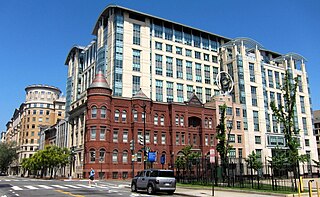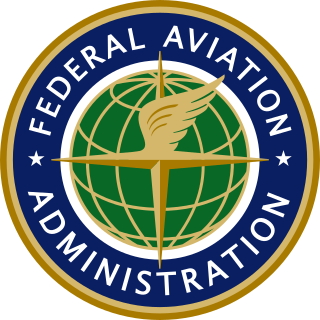Related Research Articles

The National Academies of Sciences, Engineering, and Medicine (NASEM), also known as the National Academies, is a congressionally chartered organization that serves as the collective scientific national academy of the United States. The name is used interchangeably in two senses: (1) as an umbrella term or parent organization for its three sub-divisions that operate as quasi-independent honorific learned society member organizations known as the National Academy of Sciences (NAS), the National Academy of Engineering (NAE), and the National Academy of Medicine (NAM); and (2) as the brand for studies and reports issued by the unified operating arm of the three academies originally known as the National Research Council (NRC). The National Academies also serve as public policy advisors, research institutes, think tanks, and public administration consultants on issues of public importance or on request by the government.

An aerospace manufacturer is a company or individual involved in the various aspects of designing, building, testing, selling, and maintaining aircraft, aircraft parts, missiles, rockets, or spacecraft. Aerospace is a high technology industry.

Aerospace is a term used to collectively refer to the atmosphere and outer space. Aerospace activity is very diverse, with a multitude of commercial, industrial, and military applications. Aerospace engineering consists of aeronautics and astronautics. Aerospace organizations research, design, manufacture, operate, maintain, and repair both aircraft and spacecraft.

Nondestructive testing (NDT) is any of a wide group of analysis techniques used in science and technology industry to evaluate the properties of a material, component or system without causing damage. The terms nondestructive examination (NDE), nondestructive inspection (NDI), and nondestructive evaluation (NDE) are also commonly used to describe this technology. Because NDT does not permanently alter the article being inspected, it is a highly valuable technique that can save both money and time in product evaluation, troubleshooting, and research. The six most frequently used NDT methods are eddy-current, magnetic-particle, liquid penetrant, radiographic, ultrasonic, and visual testing. NDT is commonly used in forensic engineering, mechanical engineering, petroleum engineering, electrical engineering, civil engineering, systems engineering, aeronautical engineering, medicine, and art. Innovations in the field of nondestructive testing have had a profound impact on medical imaging, including on echocardiography, medical ultrasonography, and digital radiography.

Alliant Techsystems Inc. (ATK) was an American aerospace and arms manufacturer headquartered in Arlington County, Virginia. The company operated across 22 states, Puerto Rico, and internationally. ATK revenue in fiscal year 2014 was about US$4.8 billion.

Israel Aerospace Industries, is Israel's major aerospace and aviation manufacturer, producing aerial and astronautic systems for both military and civilian usage. It has 14,000 employees as of 2021. IAI is state-owned by the government of Israel.
ASD-STE100 Simplified Technical English (STE) is a controlled language designed to simplify and clarify technical documentation. It was originally developed during the 1980's by the European Association of Aerospace Industries (AECMA), at the request of the European Airline industry, who wanted a standardized form of English for technical documentation that could be easily understood by non-English speakers. It has since been adopted in many other fields outside the aerospace, defense, and maintenance domains for its clear, consistent, and comprehensive nature. The current edition of the STE Specification, published in April 2021, consists of 53 writing rules and a dictionary of approximately 900 approved words.
Aeronautical Radio, Incorporated (ARINC), established in 1929, was a major provider of transport communications and systems engineering solutions for eight industries: aviation, airports, defense, government, healthcare, networks, security, and transportation. ARINC had installed computer data networks in police cars and railroad cars and also maintains the standards for line-replaceable units.

Aerospace Industrial Development Corporation is a Taiwanese aerospace company based in Taichung. It is one of only two Taiwanese companies with the capabilities of a traditional American or European defense prime contractor.

The Defense Logistics Agency (DLA) is a combat support agency in the United States Department of Defense (DoD). The agency is staffed by over 26,000 civilian and military personnel throughout the world. Located in 48 states and 28 countries, DLA provides supplies to the military services and supports their acquisition of weapons, fuel, repair parts, and other materials. The agency also disposes of excess or unusable equipment through various programs.
Integrated logistics support (ILS) is a technology in the system engineering to lower a product life cycle cost and decrease demand for logistics by the maintenance system optimization to ease the product support. Although originally developed for military purposes, it is also widely used in commercial customer service organisations.
The Aerospace Industries Association (AIA) -- originally the Aeronautical Chamber of Commerce (1922-1945), then Aircraft Industries Association (1945-1960) -- is an American trade association representing manufacturers and suppliers of civil, military, and business aircraft, helicopters, UAVs, space systems, aircraft engines, missiles, material, and related components, equipment, services, and information technology in the United States. It also co-sponsors, with the National Association of Rocketry, the America Rocketry Challenge (TARC), an annual competition for high school students. Member companies also give awards and scholarships to top placing teams at the TARC national finals each year, and it is funded through sponsoring companies. AIA also develops the manufacturing standards called National Aerospace Standards, which are available to aerospace manufacturers that conform to United States Military Standards for equipment manufacturing and provide standards for other various components.

The Association of Home Appliance Manufacturers or AHAM represents the manufacturers of household appliances and products/services associated with household appliances sold in the United States. AHAM also develops and maintains technical standards for various appliances to provide uniform, repeatable procedures for measuring specific product characteristics and performance features.
An interactive electronic technical manual (IETM) is a portal to manage technical documentation. IETMs compress volumes of text into just CD-ROMs or online pages which may include sound and video, and allow readers to locate needed information far more rapidly than in paper manuals. IETMs came into widespread use in the 1990s as huge technical documentation projects for the aircraft and defense industries.

The Air Traffic Organization (ATO) is an air navigation service provider in the United States of America. The ATO is the operational division of the Federal Aviation Administration (FAA).

The National Space Council is a body within the Executive Office of the President of the United States created in 1989 during the George H. W. Bush administration, disbanded in 1993, and reestablished in June 2017 by the Donald Trump administration. It is a modified version of the earlier National Aeronautics and Space Council (1958–1973).
M3 Technology, originally established as J&K Electronics Inc. in 1998, began its journey as a distributor of electronic components on Long Island. The company underwent a significant transformation in 2004, rebranding itself as M3 Technology and shifting its primary focus to the aerospace industry. This strategic pivot allowed M3 Technology to expand its expertise and become a leading provider of parts and components specifically tailored for aerospace applications.

Minneapolis–Saint Paul Joint Air Reserve Station is a United States Air Force base, located at Minneapolis–Saint Paul International Airport. It is located in the Fort Snelling Unorganized Territory on the southeast border of Minneapolis, Minnesota. It was formerly the location of Naval Air Station Twin Cities.
Civil Aerospace Medical Institute (CAMI) is the medical certification, education, research, and occupational medicine wing of the Office of Aerospace Medicine (AAM) under the auspices of the Federal Aviation Administration Office of Aviation Safety. The Institute's primary goal is to enhance aviation safety.
SX000i - International guide for the use of the S-Series of Integrated Logistics Support (ILS) specifications, is a specification developed jointly by a multinational team from the AeroSpace and Defence Industries Association of Europe (ASD) and Aerospace Industries Association (AIA). SX000i is part of the S-Series of ILS specifications.
References
- 1 2 "Status and Outlook of Metric Conversion of Standards" (PDF). dtic.mil. May 1982. p. 8.
- ↑ "Federal Register, Volume 61 Issue 176 (Tuesday, September 10, 1996)". www.govinfo.gov. 1996-09-10. Retrieved 2024-05-31.
 This article incorporates text from this source, which is in the public domain .
This article incorporates text from this source, which is in the public domain .